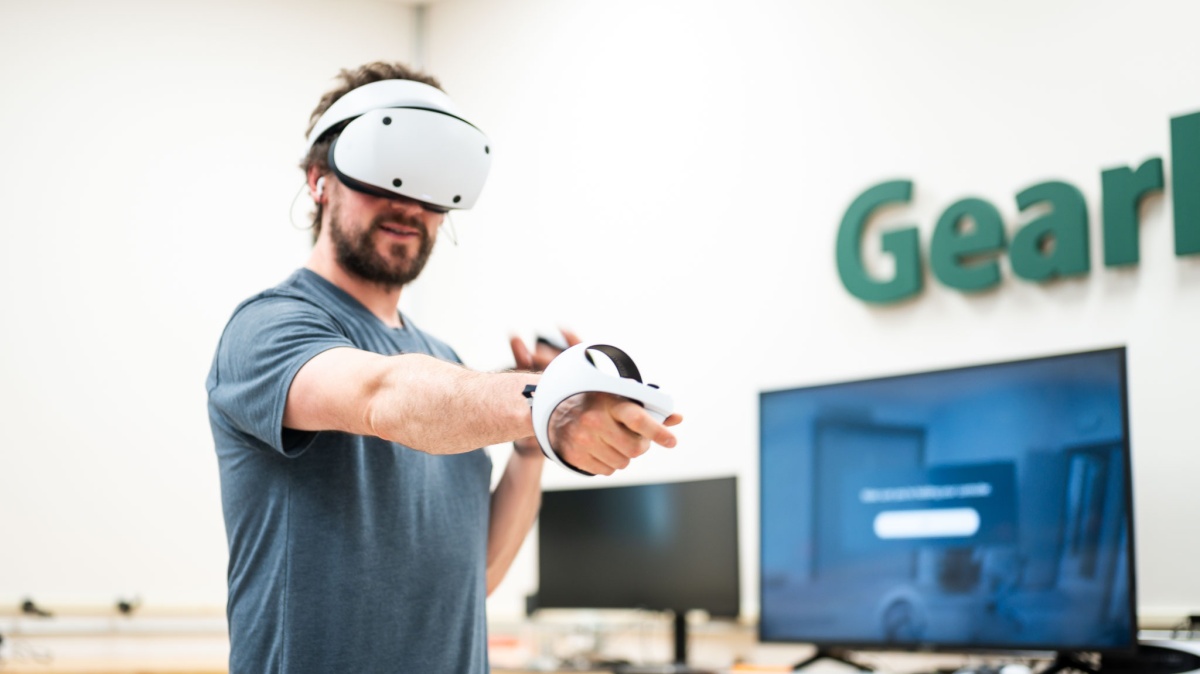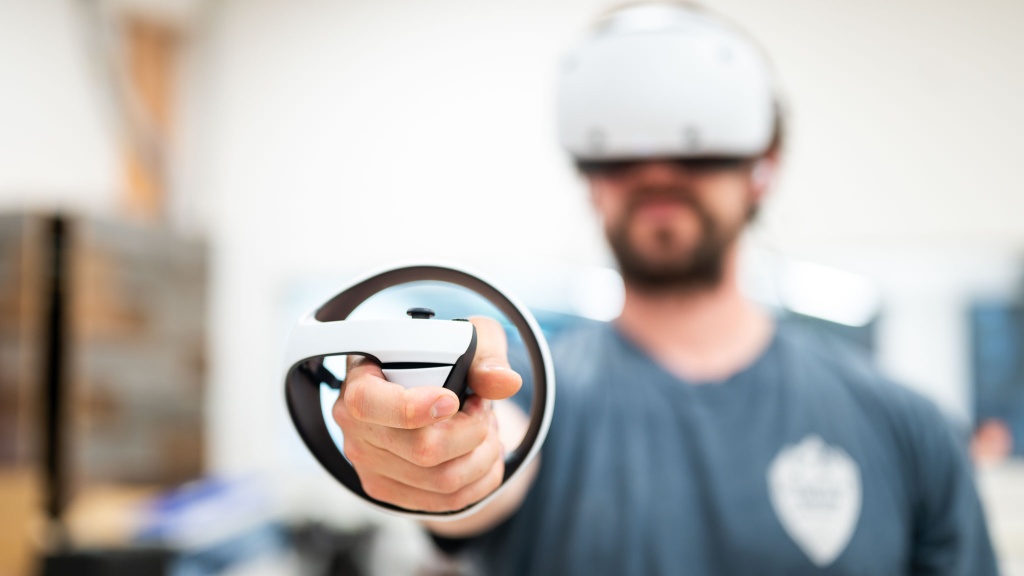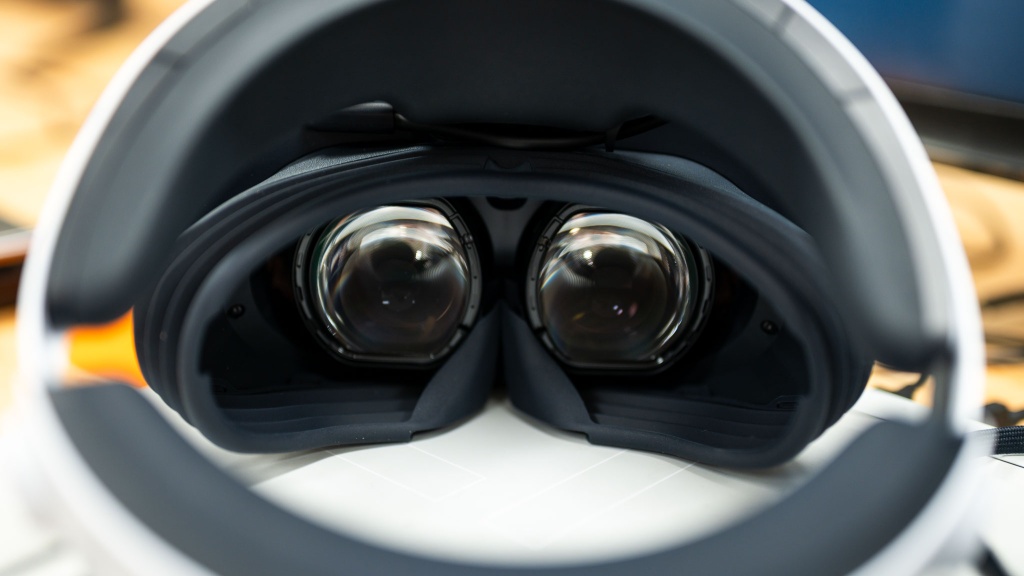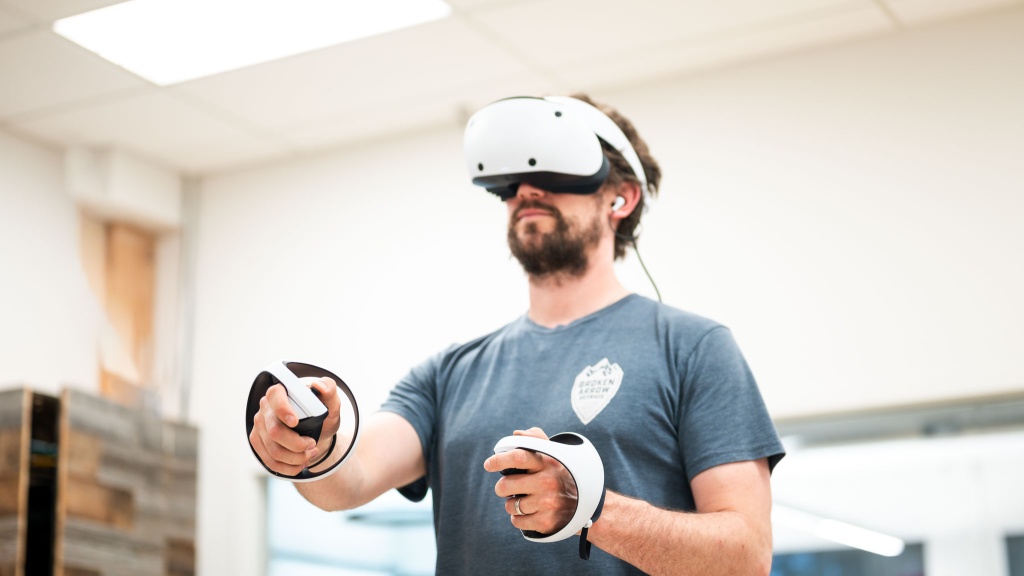Our Verdict
Compare to Similar Products
This Product PlayStation VR2 | |||||
|---|---|---|---|---|---|
| Awards | Runner Up Headset | Best Overall/Stand Alone | Working and Relaxing | ||
| Price | $550 List $549.99 at Amazon | $999 List | $500 List $379.99 at Amazon | $3,699 List | $799 List $607.44 at Amazon |
Overall Score  |
|||||
| Star Rating | |||||
| Bottom Line | This great value headset should excite PS5 players looking for upgraded VR immersion | A solid and high-performing VR headset that doesn't require a top-shelf GPU | One of the best standalone headsets on the VR market represents evolutionary improvements on the Quest 2 at a reasonable price | A sharp innovative (and expensive) display geared more toward browsing, work, and movie watching than gaming | This headset will appeal to users with glasses or who require top-notch tracking precision |
| Rating Categories | PlayStation VR2 | Valve Index | Meta Quest 3 | Apple Vision Pro | Vive Pro 2 Headset |
| Tracking (35%) | |||||
| Comfort (30%) | |||||
| Visuals (15%) | |||||
| User Friendliness (15%) | |||||
| Ease of Setup (5%) | |||||
| Specs | PlayStation VR2 | Valve Index | Meta Quest 3 | Apple Vision Pro | Vive Pro 2 Headset |
| Measured Weight | 1.31 lbs | 1.86 lbs | 1.13 lbs | 1.37 lbs | 1.94 lbs |
| Tracking type | Built-in Cameras | External Sensors | Built-in Cameras | Built-in Cameras | External Sensors |
| Per Eye Manufacturer Resolution | 2000 x 2040 | 1440 x 1600 | 2064 x 2208 | 3660 x 3200 | 2448 x 2448 |
| IPD Adjustment | Mechanical IPD: 57 - 73mm *Rough measurement |
Mechanical IPD: 58 - 70mm | Mechanical IPD: 53 - 75mm | Automatic IPD: 51 - 75mm | Mechanical IPD: 57 - 70mm |
| Measured Horizontal Field of View | N/A | 110º | 100º | 95º | 110º |
| Measured Vertical Field of View (Up) | N/A | 40º | 35º | 25º | 32º |
| Measured Vertical Field of View (Down) | N/A | 45º | 45º | 35º | 32º |
| Manufacturer Field of View | 110º | Optimized eye relief adjustment allows a typical user experience 20º more than the HTC Vive | 110º | N/A | Up to 120º |
| Manufacturer Refresh Rate | 90, 120 Hz | 80, 90, 120, 144 Hz | 72, 80, 90, 120Hz | 90, 96, 100Hz | 90, 120 Hz (only 90Hz supported via VIVE Wireless Adapter) |
| Sound | 3.5 mm port, included earbuds Bluetooth connected via the Console |
Built-in, 37.5mm off-ear | Built-in headband 3.5 mm audio port optional |
Built-in headband | Built-in, on or off-ear |
| Connection Type to PC | - USB-C | - DisplayPort 1.2
|
Stand alone (Optional PC Connection: Meta Quest Link Cable and Air Link ) |
Wifi with a 3rd party workaround | - DIsplayPort (DP to mini-DP adapter included)
|
| Room For Glasses | Excellent | Below average | Average | No | Above Average |
| Manufacturer Minimum PC Specs | N/A Uses PS5 | OS: Windows 10 Processor: Dual Core with Hyper-Threading Memory: 8 GB RAM Network: Broadband Internet connection Additional Notes: Available DisplayPort (Version 1.2) and USB (2.0+) Port Required |
Optional Link Cable Setup OS: Windows 10 / Windows 11 Processor: Intel i5-4590 / AMD Ryzen 5 1500X or greater Memory: 8GB+ RAM USB Port: 1 USB Port |
N/A | OS: Windows 11 / Windows 10 Processor: Intel Core i5-4590 or AMD Ryzen 1500 equivalent or greater Memory: 8 GB RAM or more Video Out: DisplayPort 1.2 or higher. DisplayPort 1.4 or higher with DSC is required for Full Resolution mode. |
| Manufacturer Minimum GPU | N/A Uses PS5 | NVIDIA GeForce GTX 970, AMD RX480 | Optional Link Cable Setup Supported GPUs: NVIDIA Titan X, NVIDIA GeForce GTX 970, NVIDIA GeForce GTX 1060 Desktop 6GB, NVIDIA GeForce GTX 1070(all), NVIDIA GeForce GTX 1080(all), NVIDIA GeForce GTX 1650 Super, NVIDIA GeForce GTX 1660, NVIDIA GeForce GTX 1660 TI, NVIDIA GeForce RTX 20-series (all), NVIDIA GeForce RTX 30-series Please Note: NVIDIA 3050 (laptop) and 3050ti GPUs are not recommended for use with Link. AMD 400 Series, AMD 500 Series, AMD 5000 Series, AMD 6000 Series, AMD Vega Series Please note: the Radeon RX 6500 is not recommended for use with Link. |
N/A | NVIDIA GeForce GTX 1060 or AMD Radeon RX 480 equivalent or greater. (Not full resolution) |
| Manufacturer Recommended PC Specs | N/A Uses PS5 | Processor: Quad Core + Additional Notes: Available USB (3.0+) Port Required for Headset Pass-Through Camera & USB Port Support |
Optional Link Cable Setup OS: Windows 10 / Windows 11 Processor: Intel i5-4590 / AMD Ryzen 5 1500X or greater Memory: 8GB+ RAM USB Port: 1 USB Port |
N/A | Better than Minimum Specs |
| Manufacturer Recommended GPU | N/A Uses PS5 | NVIDIA GeForce GTX 1070 or better | Optional Link Cable Setup Nvidia RTX 20 Series, AMD Radeon RX 6000 Series, or greater |
N/A | GeForce RTX 20 Series (Turing) or AMD Radeon 5000 (Navi) generations or newer required for Full Resolution mode. |
| Hardware Platform Needed | PS5 (PlayStation 5) | PC | Stand alone (optional tether to VR ready PC) |
Stand alone | PC |
Our Analysis and Test Results
The Sony Playstation VR2 takes over for the original PSVR, expanding on the streamlined experience and optimized content with higher resolution visuals, improved performance, and advanced eye-tracking.
Performance Comparison
Tracking
Our tracking metric scores the response and accuracy of VR headsets and motion controllers through extensive testing in our go-to VR apps and games. The Sony PlayStation VR2 has some excellent tracking, especially considering how it favors camera-based sensors built into the headset. While it still falls short of the flawless precision we've gotten from kits with sensor units, it reigns supreme among the built-in camera-based systems, and it even features eye-tracking, which few other headsets provide.
One game common across all the VR platforms we've tested on is Beat Saber, and as a fast-paced rhythm-based game, it makes for an excellent test for motion-tracking. The PlayStation VR2's tracking in Beat Saber was phenomenal. The headset and Sense Controllers were able to pick up everything we threw down, even connecting with far-away notes in the 360-degree songs that would trip up other camera-based sensor setups, like the Reverb G2 and Quest 2.
Tracking in the Resident Evil Village Demo was also exceptional. For the most part, everything went smoothly as we blasted our way free of pursuing monsters and used the Sense Controllers to manipulate in-game objects and maneuver through obstacles. We only noticed some tracking funkiness a couple of times, like when guns weren't held properly during reloads or once when we had to take a moment to adjust an earbud, and the game kept our avatar covering its face for the rest of the playthrough. It's hard to determine whether tracking was at fault because either of those issues could have just as likely been a bug in the game demo.
We are impressed that PSVR2 is capable of eye-tracking. That's a neat trick that's rare in current-generation VR headsets as of this publication. One way some PSVR2 titles make use of eye-tracking is with foveated rendering, which reduces GPU strain by increasing pixel density where you're looking and reducing it where you're not.
Comfort
Our comfort metric considers components such as material and design that contribute to or minimize the headset's overall comfort level. The PlayStation VR2's thoughtful design and materials made it a high performer here.
We weighed the headset at just over 1.5 pounds, with the cable running down the back of the headband to the PS5. Both the headset and controllers feel lighter in use than those from other kits, making fast-paced gaming much more enjoyable. The PSVR2's headband design is supported by the forehead to keep the weight of the visor off the face, which is a significant improvement over most headsets. Environmental light blocking is aided by a baffled rubber gasket surrounding your eyes to increase VR immersion. Quick head pans didn't upset the PSVR2 as much as other headsets. It stayed in place on the face, with only occasional light collisions with our noses.
Another area where the PlayStation VR2 defies expectations is glasses compatibility. Every other headset we tested was uncomfortable, worn over glasses, and some were downright miserable. The PSVR2's unique design that places all the visor's weight on the forehead and its ability to slide closer and farther from the face without altering the tension of the head strap leaves tons of room inside the visor for glasses. That's a vast improvement over conventional straps that smash the frames into your face and temples to keep the visor in place. A minor downside with this design is that we noticed a slight loss in the field of view (FOV) when we pulled the PSVR2 visor farther out to accommodate glasses.
Like almost every other VR headset, temps rise during intense play. We attributed PSVR2's heat retention to the rubber gasket trapping hot air between our face and the visor, allowing very little airflow. However, we still appreciate that the mask isn't pulled tightly against our face like other headsets, where sweat gets absorbed into the fabric-covered face mask.
Visuals
The visuals metric evaluates screen clarity and field of view (FOV), two elements that can help or hinder VR immersion. The Playstation VR2 scores well in our tests, providing excellent visuals.
Screen resolution is 2000 x 2040 pixels per eye at up to 120hz refresh rate, with a claimed FOV of 110 degrees. We weren't able to test the FOV as scientifically as usual without the availability of the trusty Realovirtual Workshop app we used to test the PC VR games, but FOV in Beat Saber was quite good, easily on par with other headsets in the 110-degree FOV range.
Screen Door effect (SDE) is minimal on the PSVR2. SDE refers to a visual issue where the human eye can see individual pixels and the space between them when as close to a screen as it is in VR headsets. It's like looking through a mesh screen and can detract from VR immersion. Higher resolution headsets have lower SDE, and that includes the PSVR2. Graphics and text in Beat Saber and the Resident Evil Village Demo were crisp and clear, with very little SDE.
User Friendliness
Our daily use test evaluates the headsets' ease of strapping and convenience of fine-tuning the fit. The PlayStation VR2 performed well in this analysis.
Initial fitting is a breeze: Press the button on the top right of the visor to release it, then pull it forward to create room to put it over your head. Next, you press the button on the back of the head strap to unlock it, then pull the visor and the rear head strap apart and place the headset on your head. With the backstrap secure at the lower back of your head, press the rear button and twist the dial to snug up the fit, then press the button on the top right of the visor again and pull the visor toward your face.
Interpupillary distance (IPD) refers to the distance between the center of your eyes, and the closer your IPD aligns with the headset's lenses, the better for your VR experience. IPD adjustment on the PSVR2 is done from a mechanical scroll wheel on the top left of the visor. While Sony doesn't list it in the specs, we took rough measurements to record around a 57-73mm adjustment range.
Sony's PSVR2 carries sound through earbuds mounted at the side of the head strap. They aren't as comfortable as over-the-ear headphones, but they work well and are less annoying during use than other headset designs incorporating earbuds instead of headphones. The sound from the earbuds and the integrated microphone were fine for everyday use; we had no complaints.
Ease of Setup
Our ease of setup metric gauges the user experience for each VR headset's initial setup process while considering any added hardware or PC requirements. Once again, Sony's PlayStation VR2 excels thanks to its thoughtful design, console optimization, and lack of external sensors to set up.
As you might imagine, setting up a mainstream console-based VR headset with the console it was designed exclusively for is much more streamlined than the process for PC VR headsets. To get going, power on the PS5 console, plug up the PSVR2 headset and connect the earbuds to the back of the headset. You'll be guided through the rest of the setup process from prompts on your TV, including a step where each Sense controller must be plugged into the PS5 for initial pairing.
Sony recommends a minimum 6'7" x 6'7" play area for room-scale VR. The process to set up the VR barrier is very intuitive and easily among the best we've seen. With the headset on, you look all around while the integrated cameras scan the room and make any necessary edits to the border and floors with the Sense controllers.
Usually, this is where we'd comment on the minimum PC requirements for the VR headset, but the PSVR2 is incompatible with all PC hardware, requiring a Sony PlayStation 5 to power it. Every game available for the PSVR2 will be optimized for it, so you won't have to worry about performance as long as you can find games you enjoy in Sony's more limited VR library.
Should You Buy the PlayStation VR2
We highly recommend the PlayStation VR2 for anyone who already owns a PS5 and even those who don't. The combined cost of a PS5 console and the PSVR2 headset is still less than many other PC VR kits before you even factor in the high cost of a VR-ready PC. However, if you're looking for the ultimate selection of VR games and experiences, PC VR still takes the cake.
What Other VR Headset Should You Consider?
If you don't have a PC but want to try VR, check out the truly standalone Meta Quest 3. If you're looking for excellent VR visual quality and have the funds to power it, check out the Apple Vision Pro. Whatever your needs, you'll be able to find the best vr headset in our review.












